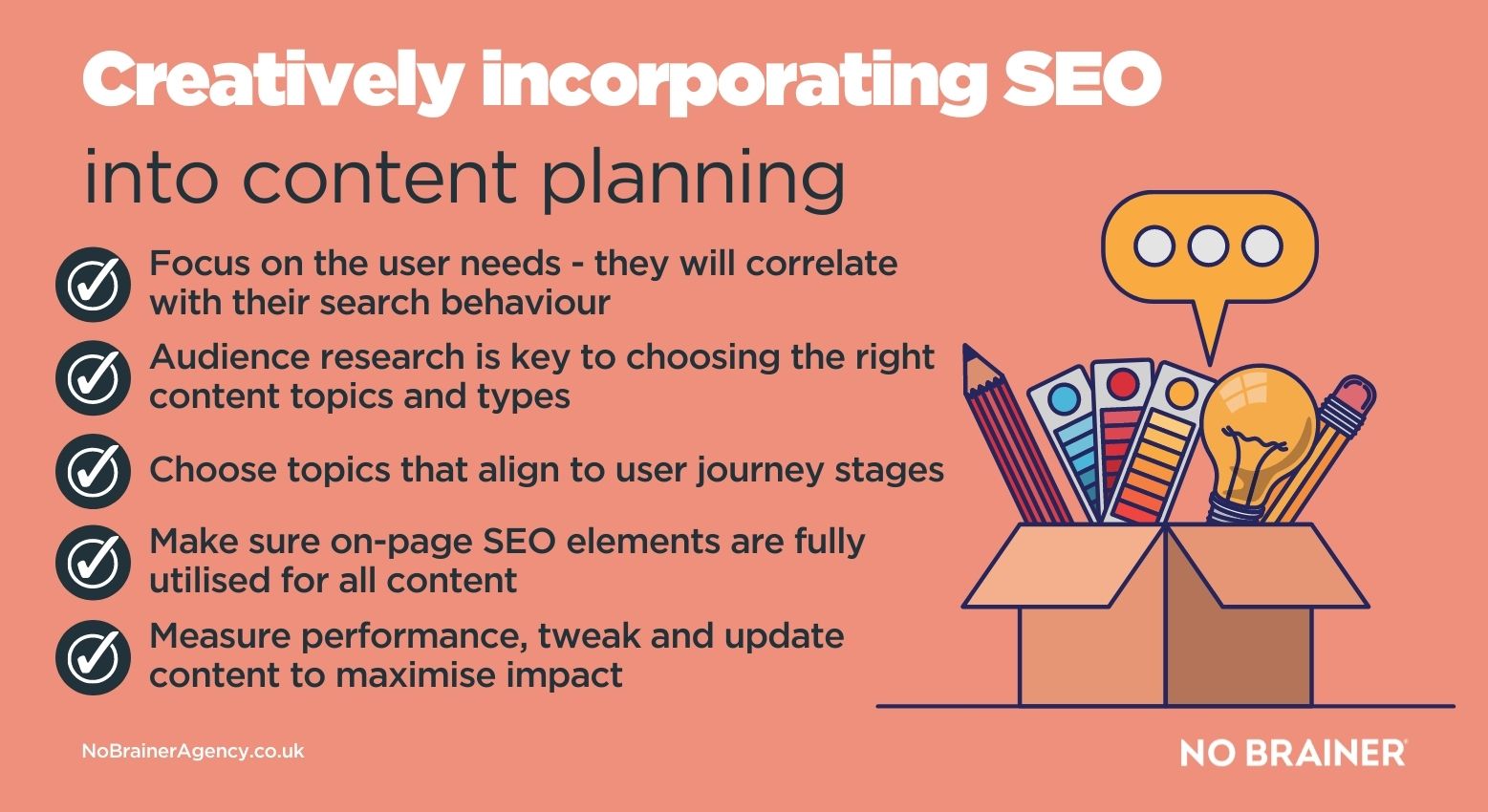For content marketers, it can sometimes seem like SEO considerations feel like constraints that they need to work within, and that doesn’t give them much scope for creativity.

It’s easy to fall into the trap of developing great content first and then trying to retrofit it with SEO relevancy and shoehorning some keywords in.
But doing this often means you end up with content that doesn’t really fit well for either your target market or search engines, despite your best intentions. No one really wins here, and the time and effort that went into the content only brings watered-down results at best.
In this article, we look at how to plan content with SEO in mind from the very start, but without having to compromise on creativity, or on effectively meeting the needs of your intended audience.
The best SEO-driven content is user-focused, not search engine-focused
No one enjoys ‘writing for search engines’, but thankfully it’s not the way we need to do things to incorporate search-friendly content into our marketing strategies.
Search engines want to provide the best information for users, which is done by evaluating the search query they used against websites with relevant content. So, the content we create should have the same goal.
Your SEO strategy should be built around what your audience needs to know and tailored to how they would look for that information.
SEO Research before ideation

You need to understand how your target market searches for the information they need in relation to what you do, turning those users into visitors on your website that convert.
Many marketers use personas to help segment their audience, map user journeys and ensure that content marketing activity is personalised to each priority section of their audience.
Personas can be invaluable to make sure that things stay on track and all of your marketing activity is contributing to your overall goals, but you also need to ensure that search behaviour is part of each persona so that SEO best practice can be ‘baked-in’ from the very start.
Keyword research is part of this, where you identify intent-led keywords that show which stage of a buyer journey your users are at when they search in a certain way, but you also need to ensure that you incorporate this knowledge into content topics that matter to your audience too, so that they will be compelled to click through from search results.
Mapping certain keywords to certain personas at certain stages of their buyer journey is a great way to underpin your content marketing strategy with solid SEO foundations.
Average monthly search volume isn’t the only indicator of a useful keyword. Your area might be fairly niche, so you can also utilise Google’s Featured Snippets and People Also Ask SERP results to identify questions that your audience are searching for information on.
Discover SEO-friendly content topic ideas
Look for questions and topic areas that naturally lend themselves to the keywords you have identified and try to find topics for each major stage of your personas’ buyer journeys.
By ensuring you have a balance of ‘top of the funnel’ content, along with informational resources that help your audience move towards a buying decision, and content designed to help get them over the line, your content strategy provides a joined-up experience that will see conversions increase.
Some tips include:
- Putting yourself in your audience’s shoes when coming up with topic ideas for each separate stage
- Be as creative as you like, getting all ideas on the table – you might be surprised how naturally they can tie in with SEO considerations
- Taking a look at your competitors and how they meet the informational needs of their audience (and if they’re not meeting their needs, explore what’s missing)
- Doing lots of searching around wider themes before identifying more focused topics. Tools like Buzzsumo are great for finding existing content on a particular theme that has done well in the past to help inspire your new ideas
Get your on-page SEO elements right when creating the content
SEO-friendly topics are one thing, but how you implement search terms into the content as you create it can also have a big impact on its organic visibility.
Tips include:
- Include a focus keyword in the content heading (H1) and page title
- Include a focus keyword in the meta description
- Use H2 tags to include more relevant keywords into the piece
- Be sure to keep your content structured clearly – using shorter sentences and paragraphs as well as bulleted lists
- Optimise any images or graphics you include with a relevant descriptive file name and alt text (but keep files sizes low!)
- Use internal links within the content to point to other relevant pages on your website, whether that’s products, categories, blogs posts or other useful information you have identified that your personas will need
- Identify other relevant pages that are connected to your topic that are high performers, and get those linking to your new page
- Explore Schema, to see if there’s any opportunity to incorporate structured data – giving you an extra edge in achieving featured snippets
Measure performance and keep your content up to date
It’s a trap that everyone in marketing has fallen into at some stage; creating content, publishing it and then forgetting about it and moving straight onto the next thing.
It’s important that SEO content performance is tracked so that you know whether your strategy is working and whether you’re taking full advantage of every opportunity with content to have maximum impact in the long-term.
SEO is rarely an instant win. Results often take months to be seen, but the flip side of this is that a piece of content that works really effectively from an SEO point of view can do so for years, driving relevant traffic to your site for a long time to come.
For that reason, it’s important to revisit your content to ensure that it’s still accurate factually as time moves on, and any statistics or cultural references that you included are as up-to-date as possible.
This means that you deliver the latest and best information to your audience over time, and search engines also generally like content that is refreshed as needed.
You can also look for opportunities to repurpose your content for a slightly different segment of your audience or other channels, to help give you the best return on the effort that it took to create.
If you would like to know how we can help with your SEO strategy, our team would love to hear from you. Get in touch using the form below.








